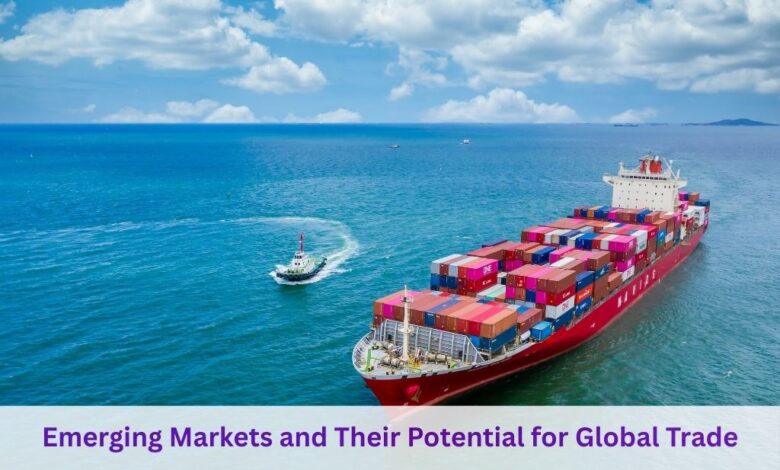Emerging Markets and Their Potential for Global Trade

The world economy has changed strongly recently. Emerging markets have grown large in world commerce even if countries like the United States, Japan, and Western Europe continue to wield influence. Strong economic growth and increased participation in trade and investment define countries like China, India, Brazil, Indonesia, South Africa, and Vietnam. The term "emerging markets " became popular in the 1980s to refer to developing nations with growth potential. Their big consumer bases, expanding sectors, and investor-friendly reforms make these markets now essential in global business. Emerging markets’ role in world commerce is examined in this article together with their economic growth, trade patterns, key industries, investment possibilities, and difficulties they confront.
Emerging Markets Defined
An emerging market is a nation progressing toward greater sophistication via industrialization, improved infrastructure, and more global commerce. Many times, these countries’ transitional economies is that of an open market from closed systems. Emerging markets include the BRICS countries Brazil, Russia, India, China, and South Africa and others like Mexico, Turkey, Indonesia, Vietnam, the Philippines, and a few Sub-Saharan African nations. Emerging markets are defined by high growth potential and an expanding role in global financial and production networks; they have shown strong growth since the early 2000s, accounting for over 60% of global GDP rise as per the IMF. From a mostly agricultural country, China has become the biggest exporter and second-largest economy. India has built a substantial manufacturing base and robust services sector. Brazil, Mexico, Vietnam, and Indonesia have also carried out structural reforms to help their development and diversification.
Economic Growth and Transformation
Particularly since the turn of the century, emerging markets have demonstrated resilience and remarkable development. Emerging and developing countries have accounted for over 60% of worldwide GDP growth in recent years, according to the International Monetary Fund (IMF).
Consider China, for example. From a mainly agricultural industry over the last thirty years, it has become the world’s biggest exporter and second largest overall economy. Another great example, India has developed a strong services sector and expanding manufacturing base owing to reforms and a young workforce.
Brazil and Mexico from Latin America, as well as Southeast Asian countries like Vietnam and Indonesia, have also experienced structural changes conducive to export-driven development. Apart from their increasing scale, these economies are becoming more sophisticated and diversifying their services and products.
Trade Dynamics of Emerging Markets
Emerging markets are distinguished most importantly by their dependence on exports to drive economic development. China’s rise was directly related to its position as a worldwide manufacturing center. Similar route seems Vietnam is taking as it develops into a major player in textiles and electronics. Exporting cars, electronics, and machinery, Mexico gains from being close to the United States.
These nations become more competitive in global markets as they develop infrastructure, educate their people, and embrace technology. Many are also ascending the value chain: from selling low-cost goods and raw materials to high-tech components, software services, and pharmaceuticals.
South-South Trade
Another trend gaining momentum is South-South trade: commerce among developing nations. For instance, trade between China and Africa has soared spectacularly as China invests in infrastructure and natural resources in exchange for minerals, oil, and agricultural goods. India has also improved its commerce links with Southeast Asian and African countries.
This variety helps to create a more balanced and multipolar world trade system by lessening reliance on conventional markets in the West.
Important Sectors Fueling Global Trade from Emerging Markets
1. Manufacturing Key suppliers
Manufacturing Key suppliers in the worldwide supply chain for electronics, vehicles, and industrial tools are countries such China, Vietnam, and Mexico. These countries draw a lot of foreign direct investment (FDI) thanks to lower labor costs, friendly rules, and better logistics.
2. Technology and Solutions
Offering software development, customer service, and business process outsourcing (BPO), India’s IT industry has grown to be a worldwide powerhouse. Countries including Egypt, Poland, and the Philippines are trailing suit, creating technological enabled services competitive advantages.
3. Energy and Natural Resources
Many rising markets have abundant natural resources. While Brazil and Argentina are agricultural powerhouses, Nigeria, Angola, and Venezuela are prominent oil exporters. Particularly as demand for energy and natural resources grows in both developed and developing countries, global supply networks depend on these resources.
4. Renewable Sources
Surprisingly, some developing economies are leading in the move to sustainable energy. China, the world’s top maker of wind turbines and solar panels, is India is developing its solar capacity quickly. These advances set them to be major actors in the worldwide green transition.
5. Digital Platforms and E-Commerce
New kinds of commerce are made possible by digitalization. In nations like Indonesia, India, and Nigeria, e-commerce is exploding. Fintech breakthroughs and mobile banking are reaching hitherto unbanked communities, therefore opening up new markets worldwide for local companies.
Investors seeking high-growth prospects often not found in developed countries will find them in emerging markets. The appeal resides in demographic benefits (big, young populations), unfulfilled consumer demand, and possibilities for technological leapfrogging.
Particularly in areas like infrastructure, renewable energy, logistics, consumer goods, and telecommunications, foreign direct investment (FDI) is still flooding these nations. The possible market for products and services grows exponentially as more people have access to smartphones, banking, and education.
Moreover the promotion of trade and investment within the GIA and between developing countries through regional trade agreements, such as the African Continental Free Trade Area (AfCFTA), the Regional Comprehensive Economic Partnership (RCEP) and Mercosur.
Difficulties and RISK
Despite the potential growth and prosperity in emerging markets, foreign investment can be bewildering due to political instability, instability in policymaking, corruption and underdeveloped legal systems. Further to this, non-commonly accepted regulations, structural problems in infrastructure and exposure to commodity price volatility pose challenges to growth. In addition emerging economies are in some cases much more sensitive to global economic shocks such as inflation in advanced countries, higher interest rates, or geopolitical conflict. For example, when the U. S. Federal Reserve hiked interest rates after 2020, many developing countries experienced huge amounts of capital outflows that caused depreciation of their currencies and spikes in inflation. Like the disruptions around COVID-19, supply chains have revealed weaknesses in the long-standing dependence on one country manufacturing centers, and therefore countries now need to create more resilient and more diverse supply chains.
The Role of Digital Transformation
Digital change is one of the drivers for market opportunity in developing countries; rapid rising smartphone, mobile internet and fintech platform adoption is helping these nations overcome traditional development obstacles. Telemedicine, e-learning, and e-governance are enhancing service delivery and raising output.
Through systems like M-Pesa, nations such Kenya have transformed financial inclusion. Another effective example simplifying digital payments for millions is India’s Unified Payments Interface (UPI). These developments allow for replicable scalable models developed here. By means of e-commerce, small and medium businesses (SMEs) also have access to worldwide markets, therefore increasing their impact on trade and economic growth.
Global Impact and Future Outlook
Emerging markets will only grow in influence as they join the global economy. By 2050, six of the seven biggest countries in the world might be contemporary emerging markets, according to the World Bank.
For developed countries, this change offers chances as well as problems. Although it may imply more competition, it also clears the path for fresh alliances, bigger markets, and joint wealth. Governments are looking for bilateral and multilateral trade agreements to strengthen economic links as multinational corporations are increasingly changing their tactics to seize market share in these areas.
Global governance organizations including the World Trade Organization, International Monetary Fund, and World Bank will also have to change to better represent the rising power of these countries. Their participation in worldwide governance procedures will help to reshape international trade and finance by become more pronounced.
How Emerging markets represent countries:
Emerging markets represent countries that are in the process of rapid growth and industrialization. These nations, including countries like India, Brazil, South Africa, Indonesia, Turkey, and Mexico, have demonstrated strong economic potential due to their expanding middle class, youthful populations, and improving infrastructure. Now more than ever, as globalization continues to reshape the dynamics of international trade, emerging markets have become more important.
Expanding Consumer Base
In fact, one of the most compelling reasons emerging markets have become so relevant to global strategy is the rise of a rapidly expanding, and desire-driven, consumer base. With millions entering the middle class each year, consumers are spending more in areas ranging from electronics to automobiles to fashion to online services. And that’s good news for multinational corporations looking for new revenue sources.
Investment Opportunities and Infrastructure Development
Emerging markets often have rapid infrastructure growth – governments in these countries are investing heavily in transport and communications, energy, and digital technologies making them more dynamic areas of development. These improvements not only enhance standard of living but also provide a much easier environment for trade: better logistics, higher quality ports, and access to digital markets enable local businesses to become more active players in global supply chains. In addition, direct foreign investment (FDI) is flooding into these regions, driven by low labor costs, demographic advantages, and business-friendly reforms. Such countries as Vietnam and Bangladesh, for example, have become worldwide centers of textile manufacturing, exporting goods to Western markets.
Digital Transformation and Innovation
The growth in technology-based services in emerging economies is helping them to “mover the current bottlenecks in development”: Mobile banking, e-commerce and digital health services are flourishing in countries where there is scarce physical infrastructure. The explosion of mobile money in Africa, and India’s digital identification system (Aadhaar) alone have increased the reach of financial inclusion significantly. Digital platforms are also revolutionizing the way that small and medium-sized enterprises (SMEs) can do international trade: With access to global marketplaces like Amazon, Alibaba, and Etsy, SMEs in emerging economies now have the freedom to reach customers in other countries without the need to install large distribution networks.
Strategic Geopolitical Positioning
Many emerging markets are found in regions that serve as geostrategically important transit countries such as Turkey, which links Europe with Asia, and Panama, which links the Atlantic and Pacific Oceans via its canal. The latter is a geopolitically and logistically important position for emerging markets to play a crucial role in global logistics and trade, as well as in international trade. Therefore, regional trade agreements and blocs such as ASEAN, Mercosur and the African Continental Free Trade Area (AfCFTA) are also promoting intra-regional cooperation and the development of trade opportunities.
Challenges Facing Emerging Markets
Despite their eventuality, arising requests face several challenges that can hamper their participation in global trade. Political insecurity, inconsistent nonsupervisory fabrics, corruption, and lack of translucency can discourage foreign investment. also, numerous of these countries calculate heavily on exports of raw accoutrements or low- value goods, making them vulnerable to price oscillations and global profitable shocks. structure gaps, similar as shy roads, anchorages, or digital connectivity in pastoral areas, can limit trade expansion. In addition, chops gaps in the labor force may circumscribe the capability of these countries to move up the value chain and produce further sophisticated goods and services.
Sustainable Growth and Global Responsibility
With lesser participation in global trade comes lesser responsibility. Arising requests are decreasingly anticipated to borrow sustainable practices, reduce carbon emigrations, and promote social equity. transnational investors and consumers are placing pressure on force chains to be ethical and environmentally friendly. Countries that prioritize sustainable development, similar as those investing in green energy, sustainable husbandry, andeco-friendly manufacturing, are likely to enjoy long- term trade advantages. For case, Chile’s investments in lithium and green hydrogen position it as a crucial player in the global clean energy transition.
The Future of Global Trade
As global power continues to shift eastward and southward, arising requests will probably come indeed more influential in shaping the rules and practices of global trade. Their participation in multinational associations similar as the World Trade Organization( WTO), BRICS, and the G20 allows them to endorse for fairer trade terms and further inclusive profitable growth. The ongoing digital revolution, combined with force chain diversification and indigenous trade integration, will probably empower arising husbandry to play a commanding part in the coming phase of globalization.
So we can say, Arising requests’ possibilities in world trade are enormous andmulti-dimensional. Driven by youthful populations, rising inflows, and fast digitalization, these nations are now the present, not the future. The chance to interact with active, expanding requests offers a strong argument for companies and governments to give great consideration indeed if obstacles still live. The emergence of new requests means further than simply profitable development; it marks a change of the world order. In the decades to come, those who comprehend, acclimate,, and make prudent investments in these requests stand to gain utmost.




